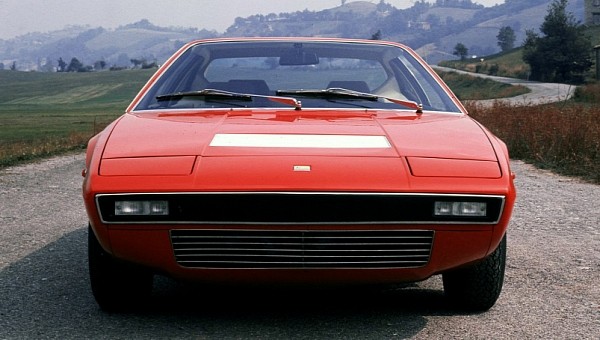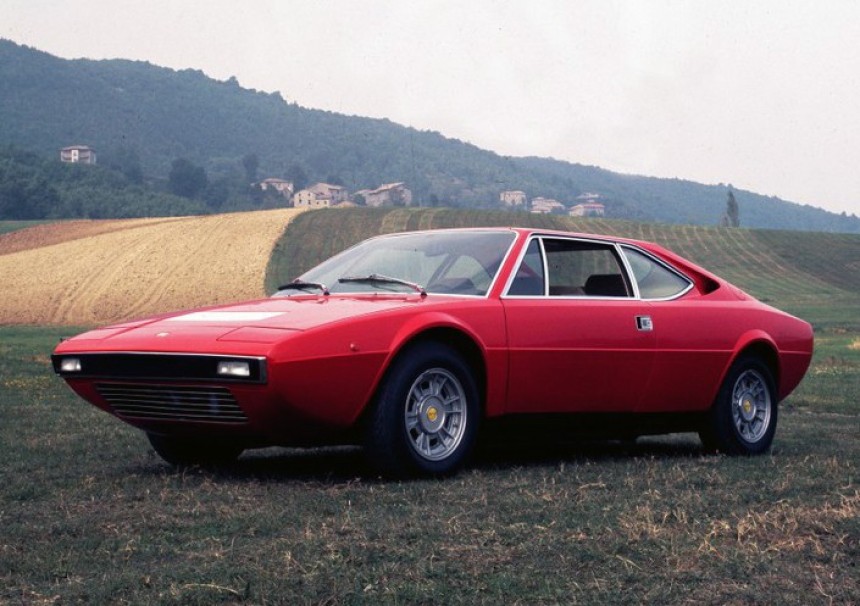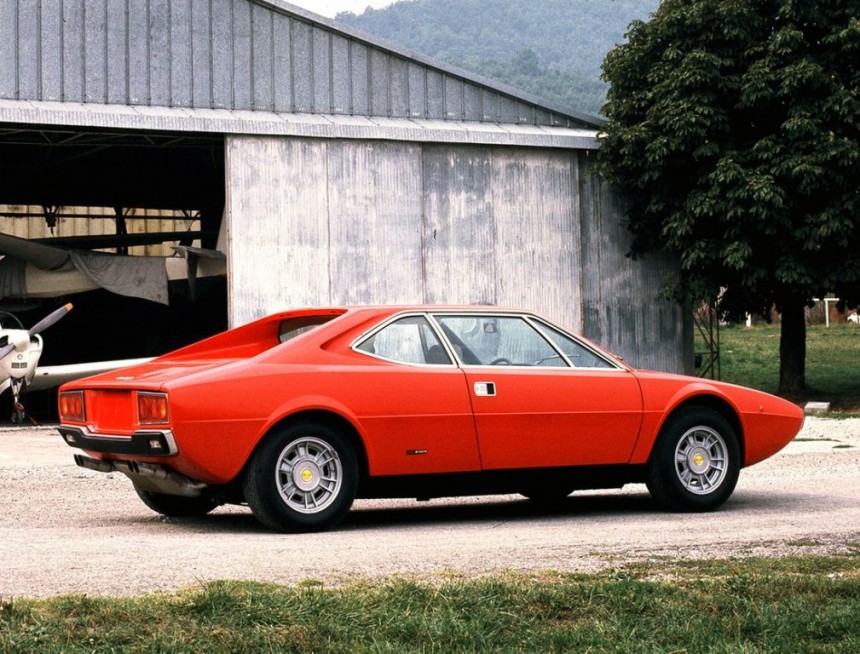A wise man once said that nothing except death and taxes is certain in this world. The man who said it didn’t live to see the Prancing Horse of Maranello debut a small-displacement V8 for the Dino GT4, but he would fully understand the reason behind the downsizing to 2.0 liters.
Introduced in late 1973, the Dino 308 GT4 was the Italian automaker’s first production model to feature a mid-engine V8. Another first for the GT4 series is the Bertone styling, a first for a series-production Ferrari. The 308 GT4 received a less powerful option in 1975 with the introduction of the 208 GT4. As implied, 308 and 208 refer to 3.0 liters, 2.0 liters, and eight cylinders.
Ferrari once made a 1.5-liter V12, a supercharged engine that needed to comply with FIA regulations for the 125 F1 to be allowed to compete in Formula 1. The 2.0-liter V8 of the Dino 208 GT4, on the other hand, is best described as a compromise. But what led to Ferrari compromising?
You’ve heard this one before, and you’ll hear it again. The 1973 oil crisis wreaked havoc across the world, affecting every single individual and most businesses. The only winners were – of course – the oil producers who saw their profits improve like crazy due to much higher oil prices.
In retrospect, more expensive gasoline wasn’t enough for the Prancing Horse to downsize the engine of the Dino 308 GT4 in such a dramatic fashion. The other reason for the introduction of the Dino 208 GT4 was taxation. In response to the 1973 energy shock, the Italian government didn’t really have a choice but to tax cars equipped with powerplants larger than 2.0 liters. Having covered the context, we should go into detail about that 2.0-liter V8.
Ferrari wasn’t flush with cash back then, which meant that it couldn’t design a brand-new engine for this application. The Italian automaker’s engineering department simply reduced the bore from 81 millimeters to 66 millimeters while keeping the 71-millimeter stroke unchanged. The 15-millimeter bore reduction is the secret to reducing the 308 GT4’s 2,926-cc engine to 1,991 cc in the 208 GT4.
Internally referred to as Tipo 106 C, the resulting engine runs a 9.9:1 compression ratio as opposed to 8.8:1 for the 3.0-liter V8. As a rule of thumb, the higher the compression ratio, the higher output of a given engine. Although it raised the compression ratio for this application, Ferrari proceeded to swap the Weber 40 DCNF twin-choke carburetors with a set of 34 DCNFs.
Constructed from aluminum, the 2.0-liter block is complemented by aluminum heads running dual overhead camshafts. The 90-degree V8 is equipped with a conventional wet sump rather than a dry sump, the latter being the golden standard for performance applications. Connected to a five-speed manual transmission of the transaxle variety, the 16-valve lump relies on a single distributor rather than the two fitted to the 3.0-liter unit.
In terms of crankshaft numbers, the Tipo 106 C produces no more than 170 ps (approximately 168 horsepower) at 7,700 revolutions per minute and 186 Nm (137 pound-feet) of torque at 4,900 revolutions per minute. By comparison, the Tipo F106 AL in the Dino 308 GT4 makes 255 ps (251 horsepower) at 7,700 revolutions per minute and 284 Nm (209 pound-feet) at 5,000 spinnies.
Dry weight is unchanged from the Dino 308 GT4, with the Dino 208 GT4 tipping the scales at 1,150 kilograms (2,535 pounds). As you may have already guessed by now, the worse power-to-weight ratio translates to worse acceleration and a lower top speed. Ferrari’s website currently lists only the top ends, with the Dino 308 GT4 capable of 220 kilometers per hour (137 miles per hour). The Dino 308 GT4’s speedometer indicates 250 kilometers per hour (155 miles per hour) at full chatter.
It’s safe to assume that roughly a second to 100 kilometers per hour (62 miles per hour) separates the midship siblings. Built around a tubular steel chassis, the Dino GT4 rocks unequal-length wishbones at every corner, plus coil springs and shock absorbers supplied by Koni. To improve the car’s handling, Ferrari also fitted two anti-roll bars.
The standard wheel-tire combo was 14- by 6.5-inch Cromodora alloy wheels and Michelin XWX tires. Behind those wheels, the Dino GT4 flaunts ventilated discs and a dual-circuit brake system. The 308 and 208 shares a similar fuel tank setup, with two tanks mounted against the rear bulkhead on either side of the engine. Their combined fuel capacity is 80 liters (21 U.S. gallons) of dinosaur juice.
In terms of stylistic differences, the Dino 208 GT4 doesn't have the fog lights of the Dino 308 GT4. Production of the Dino 208 GT4 started in late 1974, with one car built before 1975 came around. The final example of the breed rolled off the assembly line in late 1980. Ferrari claims that 840 units were produced in this period, with every single one of them leaving the factory in left-hand drive.
Ferrari once made a 1.5-liter V12, a supercharged engine that needed to comply with FIA regulations for the 125 F1 to be allowed to compete in Formula 1. The 2.0-liter V8 of the Dino 208 GT4, on the other hand, is best described as a compromise. But what led to Ferrari compromising?
You’ve heard this one before, and you’ll hear it again. The 1973 oil crisis wreaked havoc across the world, affecting every single individual and most businesses. The only winners were – of course – the oil producers who saw their profits improve like crazy due to much higher oil prices.
In retrospect, more expensive gasoline wasn’t enough for the Prancing Horse to downsize the engine of the Dino 308 GT4 in such a dramatic fashion. The other reason for the introduction of the Dino 208 GT4 was taxation. In response to the 1973 energy shock, the Italian government didn’t really have a choice but to tax cars equipped with powerplants larger than 2.0 liters. Having covered the context, we should go into detail about that 2.0-liter V8.
Internally referred to as Tipo 106 C, the resulting engine runs a 9.9:1 compression ratio as opposed to 8.8:1 for the 3.0-liter V8. As a rule of thumb, the higher the compression ratio, the higher output of a given engine. Although it raised the compression ratio for this application, Ferrari proceeded to swap the Weber 40 DCNF twin-choke carburetors with a set of 34 DCNFs.
Constructed from aluminum, the 2.0-liter block is complemented by aluminum heads running dual overhead camshafts. The 90-degree V8 is equipped with a conventional wet sump rather than a dry sump, the latter being the golden standard for performance applications. Connected to a five-speed manual transmission of the transaxle variety, the 16-valve lump relies on a single distributor rather than the two fitted to the 3.0-liter unit.
In terms of crankshaft numbers, the Tipo 106 C produces no more than 170 ps (approximately 168 horsepower) at 7,700 revolutions per minute and 186 Nm (137 pound-feet) of torque at 4,900 revolutions per minute. By comparison, the Tipo F106 AL in the Dino 308 GT4 makes 255 ps (251 horsepower) at 7,700 revolutions per minute and 284 Nm (209 pound-feet) at 5,000 spinnies.
It’s safe to assume that roughly a second to 100 kilometers per hour (62 miles per hour) separates the midship siblings. Built around a tubular steel chassis, the Dino GT4 rocks unequal-length wishbones at every corner, plus coil springs and shock absorbers supplied by Koni. To improve the car’s handling, Ferrari also fitted two anti-roll bars.
The standard wheel-tire combo was 14- by 6.5-inch Cromodora alloy wheels and Michelin XWX tires. Behind those wheels, the Dino GT4 flaunts ventilated discs and a dual-circuit brake system. The 308 and 208 shares a similar fuel tank setup, with two tanks mounted against the rear bulkhead on either side of the engine. Their combined fuel capacity is 80 liters (21 U.S. gallons) of dinosaur juice.
In terms of stylistic differences, the Dino 208 GT4 doesn't have the fog lights of the Dino 308 GT4. Production of the Dino 208 GT4 started in late 1974, with one car built before 1975 came around. The final example of the breed rolled off the assembly line in late 1980. Ferrari claims that 840 units were produced in this period, with every single one of them leaving the factory in left-hand drive.































